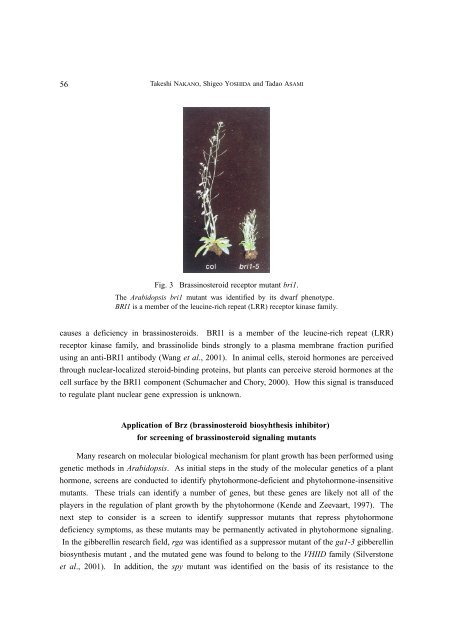No.42 - è¾²æ¥çç©è³æºç 究æ
No.42 - è¾²æ¥çç©è³æºç 究æ
No.42 - è¾²æ¥çç©è³æºç 究æ
You also want an ePaper? Increase the reach of your titles
YUMPU automatically turns print PDFs into web optimized ePapers that Google loves.
56<br />
Takeshi NAKANO, Shigeo YOSHIDA and Tadao ASAMI<br />
Fig. 3 Brassinosteroid receptor mutant bri1.<br />
The Arabidopsis bri1 mutant was identified by its dwarf phenotype.<br />
BRI1 is a member of the leucine-rich repeat (LRR) receptor kinase family.<br />
causes a deficiency in brassinosteroids. BRI1 is a member of the leucine-rich repeat (LRR)<br />
receptor kinase family, and brassinolide binds strongly to a plasma membrane fraction purified<br />
using an anti-BRI1 antibody (Wang et al., 2001). In animal cells, steroid hormones are perceived<br />
through nuclear-localized steroid-binding proteins, but plants can perceive steroid hormones at the<br />
cell surface by the BRI1 component (Schumacher and Chory, 2000). How this signal is transduced<br />
to regulate plant nuclear gene expression is unknown.<br />
Application of Brz (brassinosteroid biosyhthesis inhibitor)<br />
for screening of brassinosteroid signaling mutants<br />
Many research on molecular biological mechanism for plant growth has been performed using<br />
genetic methods in Arabidopsis. As initial steps in the study of the molecular genetics of a plant<br />
hormone, screens are conducted to identify phytohormone-deficient and phytohormone-insensitive<br />
mutants. These trials can identify a number of genes, but these genes are likely not all of the<br />
players in the regulation of plant growth by the phytohormone (Kende and Zeevaart, 1997). The<br />
next step to consider is a screen to identify suppressor mutants that repress phytohormone<br />
deficiency symptoms, as these mutants may be permanently activated in phytohormone signaling.<br />
In the gibberellin research field, rga was identified as a suppressor mutant of the ga1-3 gibberellin<br />
biosynthesis mutant , and the mutated gene was found to belong to the VHIID family (Silverstone<br />
et al., 2001). In addition, the spy mutant was identified on the basis of its resistance to the













